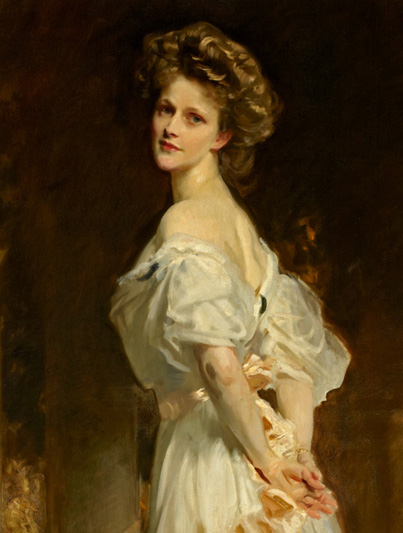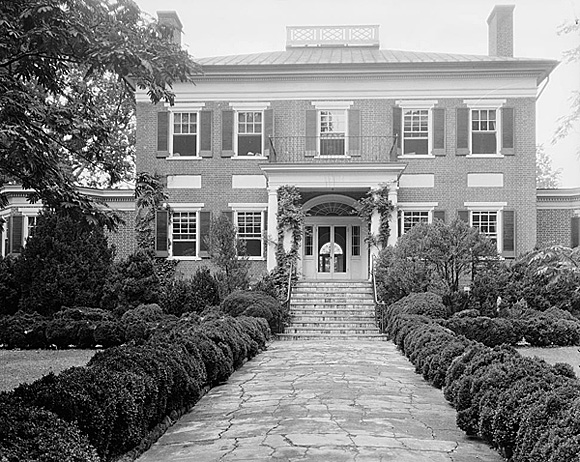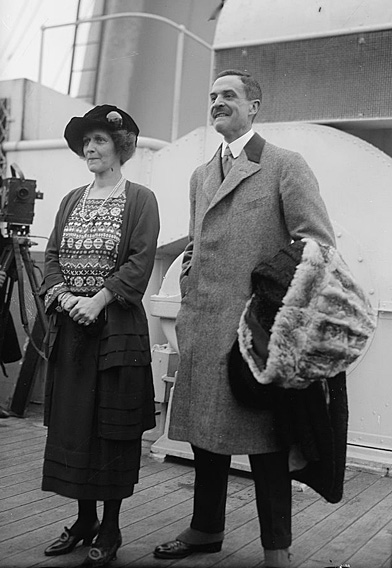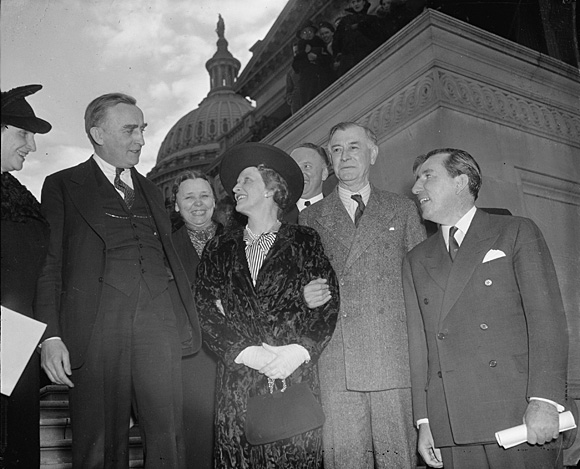

  |
|

|
Name: The Viscountess Astor (Nancy Langhorne Astor) Date: 1908 Image Number: by John Singer Sargent; National Trust Collections, UK, Comments: Nancy Langhorne began her life in 1879 in a crowded house in Danville, VA, the fifth of her parents'
eleven children. The Langhornes of Lynchburg had been wealthy before the Civil War, but, like so many others, faced
straitened circumstances in the post war period. Nancy's father, Chiswell Dabney Langhorne, was working as a tobacco
auctioneer in Danville. He was apparently quite good at the rapid-fire patter, but it was not very remunerative.
He moved his family to Richmond in 1885, where he finally struck it rich, getting construction contracts to hire in Virginia.
He was so successful at this business that he was able to relocate to the palatial estate of Mirador in Albemarle County in 1893.  Mirador, Greenwood, Albemarle County, Virginia, 1926. Frances Benjamin Johnston, Photographer, 1864-1952. Library of Congress Prints and Photographs Division, Washington, DC (Library Call No. LC-J7-VA-1229)
Nancy, after a disastrous first attempt at marriage, traveled to England where she married Waldorf Astor, the son of one of the richest men of his day. When Waldorf's father died, he inherited his title becoming 2nd Viscount Astor. He had represented the borough of Plymouth Sutton in the British House of Commons, but had to give up his seat when he was elevated to the House of Lords. In an action that was startling for its day, Nancy decided to run for the vacant seat and became the first one to accept a seat in the House of Commons. That was 1919 -- British women had had the right to vote for less than a year.  Lord and Lady Astor arrive in New York City on the Olympic on April 19, 1922. Photo courtesy of Library of Congress, George Grantham Bain Collection; Call No. LC-B2-5708-2) Nancy's political causes were education and temperance: all three of her brothers, her first husband, and her son suffered from alcoholism. Nancy also was a devout believer in Christian Science. Outspoken and flamboyant, as well as incredibly wealthy, the new Lady Astor cut a serious swath through British high society and politics. But she never forgot her Virginia roots. Despite a lengthy sea journey home, she made frequent visits to Mirador, participating enthusiastically in the local fox hunts. Her brother, William ("Buck"), who had bought a farm near Warren, took her out shooting birds when she came to Virginia. Once being reprimanded for a cutting remark, she said, "I'm a Virginian. We shoot to kill!"  Lady Astor welcomed at the U.S. Capitol in Washington, D.C., on January 27, 1938. Lady Astor, the former Nancy Langhorne of Virginia
and then a member of the British Parliament, received a warm welcome when she looked in on the U.S. Senate that day. L to R: Senator Joseph
O'Mahoney, Senator Hattie Caraway, Lady Astor, Senator Harry Byrd, Senator Key Pittman, and Senator Claude A. Pepper. Photo courtesy of the Library of
Congress, Harris & Ewing Collection; Call No. LC-H22-D3125.
Lady Astor welcomed at the U.S. Capitol in Washington, D.C., on January 27, 1938. Lady Astor, the former Nancy Langhorne of Virginia
and then a member of the British Parliament, received a warm welcome when she looked in on the U.S. Senate that day. L to R: Senator Joseph
O'Mahoney, Senator Hattie Caraway, Lady Astor, Senator Harry Byrd, Senator Key Pittman, and Senator Claude A. Pepper. Photo courtesy of the Library of
Congress, Harris & Ewing Collection; Call No. LC-H22-D3125.Lady Astor was lacking in political savvy. About the German leader, Adolf Hitler, she commented, "No one can take him seriously with that mustache. He looks too much like Charlie Chaplin." Lady Astor was a loyal donor to the University of Virginia, paying for a set of squash and handball courts, long known as the "Lady Astor Courts." She also arranged for the Astor collection of Native American photographs and artifacts to be given to the University, apparently still there in the attic of Cabell Hall. Lady Astor lived until 1964, the last survivor of the five "Langhorne Beauties." She passed away at the home of her daughter, Nancy Astor, at Grimsthorpe Castle in Lincolnshire, England. Evelyn Edson, President
Scottsville Museum Copyright © 2020 by Scottsville Museum |
|
|
|
Museum
Archive
Business
Cemeteries
Church
Events
Floods
For Kids
Homes
Portraits
Postcards
School
Transportation
Civil War WWII Esmont Search Policy |
||||
|
Scottsville Museum · 290 Main Street · Scottsville, Virginia 24590 · 434-286-2247 www.avenue.org/smuseum · info@scottsvillemuseum.com Copyright © 2020 by Scottsville Museum |
||||